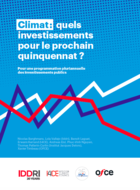The 26th COP on climate in Glasgow, under the United Kingdom’s presidency, is a first credibility test and a key milestone for at least two issues at the core of multilateral climate negotiations: the dynamic of collective ambition set in motion by the Paris Agreement, and climate finance promised at Copenhagen’s COP15. This post explains the state of play on these and other important items on the agenda (mitigation, finance, carbon markets, adaptation, real economy), and suggests some key questions to assess success at COP.
Mitigation
Two of the four goals that the UK presidency sets itself for COP26 relate to milestones set years ago. First, on reducing emissions, COP26 is the deadline by which countries should submit new and enhanced pledges to 2030 (nationally determined contributions, or NDCs), and long-term low emissions development strategies (LT-LEDS), usually to 20501 . As a reminder, the Paris Agreement is built on successive five-year cycles to progressively ratchet up national ambitions, so that they align over time with the common objective goal of reaching net zero emissions by the middle of the century. COP26 marks the first step up in this ambition mechanism, and a first test of its credibility. At the outset, it is worth noting that the way the Presidency describes the goal itself (“secure global net zero by mid-century and keep 1.5 degrees within reach”) is a testament to the effectiveness of, among others, the IPCC Special Report on 1.5°C (2018) in shifting the benchmark for climate ambition from 2°C to 1.5°C: the quantified objectives of global net zero CO2 by 2050, and -45% CO2 by 2030 on 2010 levels are now central to any overarching assessment of progress.
A week from Glasgow’s start, the picture is not rosy: though three quarters of countries (144/191) submitted again an NDC, these only represent over half of global emissions, mainly because heavyweights Chine and India are still missing to the call (representing respectively 27% and 7% of global emissions). But just as importantly, an estimated 64 countries (source: Climate Watch) submitted an NDC that is equal or worse than the previous one in terms of ambition, in direct contradiction of the Paris Agreement text2 , including from OECD countries such as Australia, Mexico, or the large economy of Brazil. Overall, though current submissions represent a progress from 2015, GHG emissions are still projected to rise by 16% by 2030 on 2010 levels, according to the UNFCCC NDC synthesis report from September. It seems particularly difficult for China (host of UN CBD COP15 on biodiversity) to evade its 2015 commitment to submit an enhanced NDC; but importance should be given in also ensuring all developed countries respect their commitments. Though the needle may progress during COP on these short-term commitments, the gap will be far from closed; all the more reason to remind ourselves that ambition cannot be reduced to numbers in NDCs, and that progress has been made at the domestic and sectoral levels, in terms of governance, targets and policies (IDDRI, 2021).
Only 33 countries formally submitted an LT-LEDS, an understandable discrepancy since countries are merely invited to submit one, despite the significant role they can play to enhance the ambition and implementation of NDCs (IDDRI, 2019). Interestingly, South Africa and Indonesia’s recent and ambitious submissions, and growing support from multilateral development banks for the development and implementation of LT-LEDS, show that there is a growing recognition of how much of a central process they can be for addressing short- and long-term climate and development goals (MOPAN, 2021). The development of an LT-LEDS is a natural anchor for a net-zero target: clarifying its perimeter, exploring economic transformations needed, ensuring its implications are championed by all parts of the governments and the civil society. Therefore, an LT-LEDS should also be viewed as a compulsory step to increase the credibility of recent political announcements of net-zero goals from China, Brazil, Turkey and particularly for fossil-dependant Russia and United Arab Emirates.
Additionally, COP26 could send a signal towards a greater accountability on net-zero targets. While the boom of these commitments, now covering two thirds of the global economy (ECIU, 2021), is a good sign of gradual ownership of the climate challenge, there is a real risk of backlash on two accounts. First, some developing countries push back on the ‘net zero’ focus as it is understood to mean “calling for all countries to adopt net-zero targets by 2050”. In reality the IPCC posits a global net-zero objective by 2050 to keep 1.5°C within reach, and the UK Presidency should clarify it is encouraging countries to define how and by when they could reach net zero, depending on their circumstances. Secondly, just as the Race to Zero led by UN Climate Champions has defined what counts as a genuine ‘starting line’ for commitments to net zero by businesses and local authorities (transparency, perimeter of emissions, use of offsets), countries at COP26 should clarify what a good faith net-zero target for a country looks like, e.g. what use of international carbon credits, assumptions on LULUCF/negative emissions technologies, etc.
Finance
The second goal that was a long time coming for this COP is finance, and more specifically the promise from developed countries at Copenhagen’s COP15 (2009) to mobilise 100 billion USD a year by 2020 from public and private sources to support developing countries’ needs. This figure has little justification in itself: its genesis is surprisingly mysterious; everyone agrees the actual needs will be much higher. But this goal serves to demonstrate a solidarity principle that is key for a universal commitment to action, and is, as such, incredibly important for the overall dynamic of ambition. According to the latest OECD estimates on 2019 figures, we are still at least 20 billion USD short, and financing trends are worryingly flat between 2018 and 2019, even before the pandemic hit. Canada and Germany have been missioned by the UK presidency to prepare a plan clarifying how developed countries would collectively step up, which may include more commitments for the 2021-2025 period, and more clarity on how to set up a new collective quantified goal by 2025 (as promised in Paris’ COP21). Predictably, the more outspoken developed country parties are publicly lamenting the ‘broken promises’ undermining the multilateral system, and the broader background of inequalities in global vaccine distribution (posing another logistical headache for COP organisers) and capacities for economic recovery are only exacerbating these tensions (LMDC Statement).
Carbon markets
Thirdly, while most of the rules of implementation of the Paris Agreement (‘Rulebook’) have been agreed in Katowice’s COP24 in 2018, the rules for international carbon markets (so-called ‘cooperative approaches’ under Art. 6) are still missing. At the heart of the disagreement lies a risk of double-counting emission reductions, if credits are not traded with sufficient transparency and accountability. Unlike previous market mechanisms under the Kyoto Protocol, all countries are today accountable of their emissions, and there is no “black hole” where emission reductions made are automatically “additional”. At Madrid’s COP25, over 30 countries from EU, AILAC (Independent Alliance of Latin America and the Caribbean), and SIDS (Small Island Developing States) led by Costa Rica laid down what robust rules meant for them in the San Jose Principles, and preferred deferring a decision rather than accepting rules that did not meet these standards and could undermine collective emission reduction. Two years later, technical negotiations have been rare and challengingly held online; but the main issue seems more like a political one. Brazil, a key blocking country on this topic, needs to be reassured that there will be financial incentives towards the preservation of the Amazonian forest, and its contribution to global climate stability.
Adaptation
With such high pressure on country commitments on mitigation and finance, adaptation issues may struggle for technical attention in Glasgow, but will remain politically vital, considering how tangible climate impacts have become all around the world, and the stark warning on extreme weather events from the IPCC WG1. In the long-term goals of the Paris Agreement, adaptation was on equal footing with mitigation and finance, but only 25 countries have formally reported on their efforts to understand and prepare for climate impacts. Countries collectively struggle to articulate how to advance and assess progress towards the qualitative global goal on adaptation; South Africa’s proposal to quantify it, though preliminary, shows a real desire to “operationalize” adaptation issues, and the global goal in particular (IDDRI, 2014). These discussions could build on the Adaptation Committee’s technical paper on reviewing collective adaptation progress.
Real economy
Finally, multilateral climate conferences offer a high-level platform to launch and, take stock of public and private initiatives to advance ‘real economy’ action. A key area where new commitments are hoped include reducing the consumption of coal, on the back of the No New Coal Power Compact launched at UNGA, and the G7, China and South Korea’s commitment to stop building coal abroad. Short-lived climate pollutants are decisive for effective climate mitigation this decade; methane from fossil production, agriculture and waste management could be curbed through support to the Global Methane Pledge, to be launched by the US and the EU.
A massive technical and political challenge for post-Brexit ‘Global’ Britain, COP26 will be a key test of many of the principles that underpin the multilateral climate negotiations. But it is not the ‘last hope’ for climate action.
Key questions to assess success:
- Have new NDC or LTS been submitted or promised from key players? (in particular China, India, Australia, Mexico, Brazil)
- Has the criteria for robust net zero targets for countries been clarified?
- Has an agreement been found on rules for international carbon markets that prevent double-counting emission reductions?
- Has a credible plan been put on the table to deliver the 100 billion USD?
- Has the discussion on operationalising the global goal on adaptation progressed with concrete proposals?
- Which commitments have been made to accelerate ‘real economy’ transformations (in particular to curtail deforestation, decrease coal use, reduce methane emissions)?
- 1These documents differ in nature: signatories to the Agreement are obligated to submit NDCs but only encouraged to submit LT-LEDS.
- 2Art. 4.3: “Each Party's successive nationally determined contribution will represent a progression beyond the Party's then current nationally determined contribution and reflect its highest possible ambition […]”.




